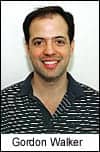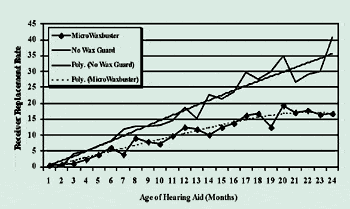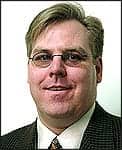Knowles Electronics and Deltek bring a history as innovators to the hearing aid component market.
For the last 50 years, Knowles Electronics, Itasca, Ill, has been providing components to the hearing health care market. Among the company’s notable accomplishments is the miniaturization of the transducer, which allowed for the development of smaller hearing devices. Knowles develops and builds its components from raw materials to the finished product, and then markets them to hearing device manufacturers. It uses a variety of state-of-the-art automated processes, which includes the use of precision lasers and assembly tooling. This enables the company to deliver a low-cost, consistent product to the market.
Among its current product offerings are microphones—both uni- and omni-directional designs—a wide variety of receivers, including ferrofilled and D-Amp powered ones; and wax-control devices. Knowles’ younger sibling, Deltek, Itasca, Ill, manufactures a full line of switches, trimmers, volume controls, and telecoils.
Knowles’ commitment to hearing health goes beyond the marketplace. Northwestern University, Evanston, Ill, named its Hugh Knowles Center for Clinical and Basic Science in Hearing and Its Disorders in honor of the company’s founder.
Knowles was acquired by the Dover Corporation in August 2005. The New York-based company is a manufacturer of industrial products.
Hearing Products Report (HPR) recently spoke with Gordon Walker, general manager of Knowles Electronics, and Brad Olson, product manager for Deltek, about what makes each division stand out, how it delivers high-quality, low-cost components to the marketplace, and the future.
|
HPR Knowles and Deltek make numerous components that are used throughout the hearing industry. What makes your components different/stand out from your competitors?
Gordon Walker At Knowles and Deltek, we pride ourselves on superior quality, delivery, and service.
Brad Olson But if we had to name one area where we have made our reputation for 50 years, it is that of technical leadership.
Walker We offer the most advanced, compelling solutions on the market. Ferrofluid offers screen-less damping for receivers—addressing the wax problem—while significantly improving shock performance. The FK is the smallest receiver on the market, ideal for the new RITE devices targeting a “mild-moderate” hearing loss. We have also consistently been the leader in smaller, more robust, high-performance transducers.
Olson And electromechanical devices like our push button with overtravel for superior tactile feel also contain innovations, which directly and positively impact the end-user experience.
HPR You pride yourself on technical innovation. What process do you follow in developing or adapting new processes or products? Do you respond to market demands or try to anticipate them?
Walker We have always listened very carefully to our customers about their wants and needs in component functionality. We also try to look at where the industry is heading in terms of both audiological research into ways instruments can improve people’s lives as well as to understand the implications of new or emerging market segments.
HPR What do you consider your most important technological innovation?
Walker On the transducer side, the HiFi FK can dramatically improve the quality of sound in hearing instruments by delivering 10 to 20 decibels of more output between 5 and 10 kilohertz than traditional receivers in a package small enough for ITC instruments.
Olson In electromechanical products, we anticipate that the improved contact mechanism we are using in our recently launched digital volume controls will have a great impact, both because of its improved durability and also because it will be easily integrated into a wide range of multifunction control devices. This will facilitate the continuing increase in functionality per unit area on the hearing aids themselves.
HPR Where do you see component technology heading—what does the next iteration look like?
Walker Micro-Electro-Mechanical Systems (MEMS) technology is clearly just around the corner. Knowles has had tremendous success introducing MEMS-based microphones into the consumer/mobile handset market, and we look forward to leveraging that experience to deliver new and innovative products to the hearing instrument market.
Olson We also see the form factor of our electromechanical controls changing, as devices become flatter and more cosmetically integrated with the latest industrial design concepts of the hearing aid manufacturers.
HPR What is the toughest aspect of being in the component market right now?
Walker The pace of innovation and new platform development in the industry is very exciting and presents new challenges every day. We are thrilled to be a part of it.
HPR While you are a technological leader, you are also a cost leader—priding yourself on delivering components at an attractive cost. How do you achieve this?
Olson Driving costs down is all about execution. Customers see the external results, but internally there are constant efforts being made to improve operational efficiency. These are both to minimize resource use, and to ensure that the resources we do deploy give the most benefit. In the last few years, Knowles and Deltek have spent innumerable resources on initiatives like upgrading to a state-of-the-art Oracle ERP system, and revamping our new product development processes to a stage-gate model used at other cutting-edge firms like Motorola.
HPR What is your customer profile?
Walker We sell to every hearing instrument manufacturer and many larger repair labs.
Olson But, ultimately, we consider the audiologists and end users our customers, too. This indirect relationship with end users is part of the reason we try to forge strong partnerships with the hearing instrument manufacturers, who help us understand the entire market [more fully].
HPR How do you market your products to this customer base? How do you provide service to them?
Walker We are willing to try almost anything for our customers, with [the aid of] an extensive applications engineering team as well as focused account management teams. We do everything we can to be sure our products provide the maximum performance possible to the hearing instrument.
Olson And we actively solicit customer input to ensure we are developing products that benefit their customers as well. We also share knowledge by participating in a wide variety of hearing industry association groups and trade shows.
HPR Knowles has much better name recognition than Deltek. How is Deltek developing its own market presence and name recognition?
Olson The Deltek division has been recognized as a growth area within the Knowles family, as evidenced by the nearly threefold growth in our business in the last 2 years. As such, we have increased both research and development spending, and our marketing budget. It is hoped that the joint effect of these activities will be to create more exciting new products, and then to ensure that our customers are aware of them. Of course, Deltek will leverage the relationships and history of the Knowles Electronics business as we do this, but we will also provide our own innovations to the industry. Moreover, with increasing component integration and continuing use of value-added subassemblies, we will also be acting as a partner with the Knowles Electronics division on many projects.
HPR Where do you see Knowles and Deltek heading in the future?
Walker Knowles and Deltek are dedicated partners to the hearing health industry, and we look forward to helping our customers deliver a better user experience to patients in the future.
Olson Yes, in some sense we are heading to the place where we have always been, the position of industry leader and technical innovator.
N.L. Shepherd is a contributing writer for Hearing Products Report.







